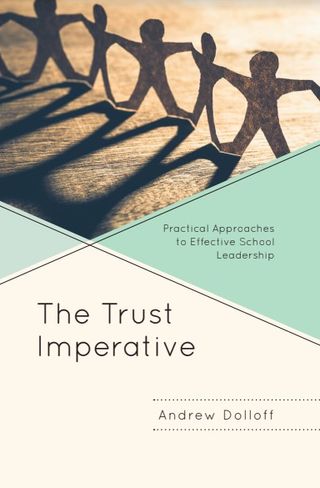Quiet quitting is a viral term with a meaning that’s open to interpretation. Some say it entails mentally checking out from your job and doing just the bare minimum to avoid getting fired. Others claim that despite the negative-sounding connotations, quiet quitting actually refers to establishing healthy work-life boundaries and not working outside the hours you are paid for or engaging in activities beyond the scope of your position.
No matter how you define it, quiet quitting has important implications for educators.
“It is detrimental for us to have quiet quitters who are disengaged from the work, but it's also very important that we're helping to build some work-life balance to retain the amazing teachers that we have,” says Dr. Andi Fourlis, Superintendent of Mesa Public Schools, the largest district in Arizona. “Teachers are known for not having a very good work-life balance, they become dedicated to their children. And so they work 24 hours a day, seven days a week, 12 months a year.”
Fourlis and three other superintendents discuss how they guard against burnout in their districts by encouraging positive work-life balance.
Quiet Quitting and Culture of Overwork In Education

About a decade ago, Dr. Brian Creasman was the opposite of a quiet quitter. In fact, he succumbed to the dark side of overwork as a principal. “I was working 80 hours a week,” says Creasman, now superintendent at Fleming County Schools in Kentucky. “I would get to school at 4:30 a.m., I would leave at 10 p.m.”
The intensity and stress of this work schedule twice landed him in the hospital with an irregular heartbeat. Creasman, 2020’s Kentucky Superintendent of Year, realized that not only did he have to change but that the culture of education needed an update as well. “We are trained from teacher to principal to superintendent to focus on the health and wellbeing of students – ours comes last,” he says.
Creasman is now dedicated to updating that mindset and improving the lifestyles of educators. His book addressing that, Prioritizing Health and Well-Being: Self-Care As a Leadership Strategy for School Leaders, will be published in October.
A healthy work-life balance might look different in different schools and districts but a key is creating a culture that recognizes that educators are not truly helping their kids when they don’t take care of themselves. “We can't do our work if folks aren’t okay. We can't be our best if people aren’t well,” says Dr. Curtis Cain, superintendent of the Rockwood School District in Missouri and AASA’s 2022 superintendent of the year.
Promoting Work-Life Balance in Your District

Dr. Andrew R. Dolloff, superintendent of the Yarmouth School Department in Maine, is the author of The Trust Imperative: Practical Approaches to Effective School Leadership. His advice for promoting a culture of work-life balance: “You need to focus on what's important, and a lot of the minutia may not be.”
With this thinking in mind, Dolloff frequently lets staff at his district’s central office leave an hour early on Fridays in the summer and cuts meetings short if the agenda items have all been met. This naturally helps guard against the wrong type of quiet quitting.
“You get so much more mileage with your staff when you say to them, ‘Hey, the rest of the afternoon is yours,’” he says. “In education, we don't have a lot of additional financial resources to provide people with other incentives, and studies show that those aren't all that effective anyway. What we can do is try to give people back a little bit of their time.”
Providing a diverse network of support is also key. In Fourlis’ district, they are creating teacher teams so educators can help one another and are not isolated. Each school has a counselor who is available to teachers in addition to students. The district is also providing instructional coaches who Fourlis says can help teachers realize it’s okay to work less. “Many, many of our teachers, are working around the clock, and they need to be given permission that ‘What you're doing is enough, it is okay to take good care of yourself.’”
Addressing Negative Quiet Quitting
On the opposite end of the spectrum, the education field, like others, has those who have checked out from their work. Individuals who appear to be truly quiet quitting in the negative sense of the term should be met with to discuss the issue, school leaders say.
Dolloff holds these meetings in private and tries to approach each one with curiosity and compassion. For instance, one employee of his was suddenly constantly late. Rather than tell her if she wasn’t on time her pay would be docked or it would go on her evaluation, Dolloff met with her and said, “Hey, we noticed that you're not getting here on time. It's been pretty consistent. This is a new pattern for you. What's going on?”
As it turned out her partner was having significant health challenges and she was struggling to handle everything. “By showing empathy, we were able to help her figure that out, and yet also get her to work on time,” Dolloff says.
Cain agrees that the best way to deal with a negative form of quiet quitting is with compassion.
“If you see someone who is struggling, or someone operating in a manner that is atypical for how they typically operate, I think it's important that we have a conversation. What can we do? What support can we provide? How can we be of assistance?” he says.
Promoting wellness in schools needs to be a teamwide effort. “It's not just about the administrator supporting the teacher,” Cain says. “It’s the teacher supporting the instructional assistant in the classroom. It’s supporting a fellow teacher. It's the teacher checking on the administrator.”
He adds that all educators need to look at colleagues and ask, “What can we do to help make sure that you're okay so that you are then okay to be working with kids?”


